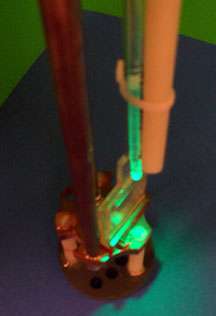Paramecia adapt their swimming to changing gravitational force

Using a high-powered electromagnet, Brown University physicists Karine Guevorkian and James Valles have created a topsy-turvy world for the single-celled paramecium. They have managed to increase, eliminate and even reverse the effects of gravity on the tiny protozoan, changing its swimming behavior and indirectly measuring its swimming force.
For many single-celled organisms living in water, the force is always against them. The classic example is the slipper-shaped paramecium, which consistently swims harder going up than going down, just to keep from sinking. Now physicists Karine Guevorkian and James Valles of Brown University have worked out a way to turn gravity on its head and see how the creatures respond.
The researchers placed a vial with pond water and live paramecia inside a high-powered electromagnet at the National High Magnetic Field Laboratory in Tallahassee, Fla. The organisms are less susceptible to a magnetic field than plain water is, so the magnetic field generated inside the vial "pulls" harder on the water than on the cells. If the field is pulling down, the cells float. If it's pulling up, they sink.
Using water alone, Valles and Guevorkian were able to increase the effect of gravity by about 50 percent. To increase the effect even further, they added a compound called Gadolinium-diethylene-triamine-pentaacetate (Gd-DTPA) to the water. Gd-DPTA is highly susceptible to induced magnetic fields such as those generated in electromagnets. This allowed the researchers to make the water much "heavier" or "lighter," relative to the paramecia, achieving an effect up to 10 times that of normal gravity. The magnetic field is continuously adjustable, so Valles and Guevorkian were also able to create conditions simulating zero-gravity and inverse-gravity.
By dialing the magnetic field up or down, the researchers could change the swimming behavior of the paramecia dramatically. In high gravity, the organisms swam upward mightily to maintain their place in the water column. In zero gravity, they swam up and down equally. And in reverse gravity, they dove for where the sediments ought to be.
"If you want to make something float more," said Valles, "you put it in a fluid and you pull the fluid down harder than you pull the thing down. And that's what we basically do with the magnet. That causes the cell to float more – and that turns gravity upside down for the cell."
Cranking the field intensity even higher, Valles and Guevorkian could test the limits of protozoan endurance. At about eight times normal gravity, the little swimmers stalled, swimming upward, but making no progress. At this break-even point, the physicists could measure the force needed to counter the gravitational effect: 0.7 nano-Newtons. For comparison, the force required to press a key on a computer keyboard is about 22 Newtons or more than 3 billion times as strong.
Space-based research has demonstrated many puzzling biological effects related to reduced gravity, such as changes in bone cell development and gene expression. But methods for manipulating gravity in the Earth-based laboratory have been few and troublesome, hindering further research in these areas. This new method will allow researchers to subject small biological systems to gravitational effects similar to those encountered in space, allowing less expensive and more complex experiments on the biological response to altered gravity.
Source: Brown University





















